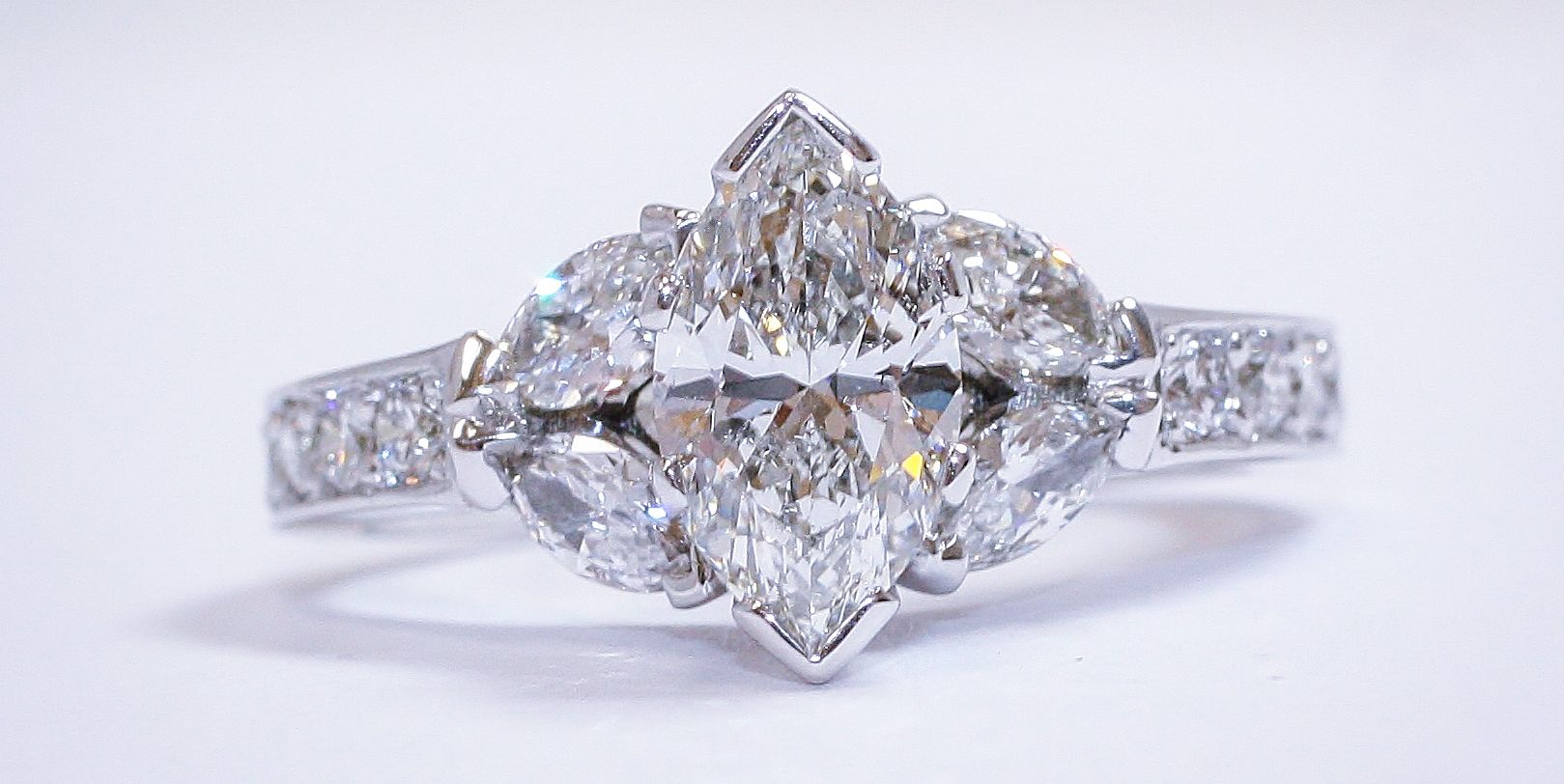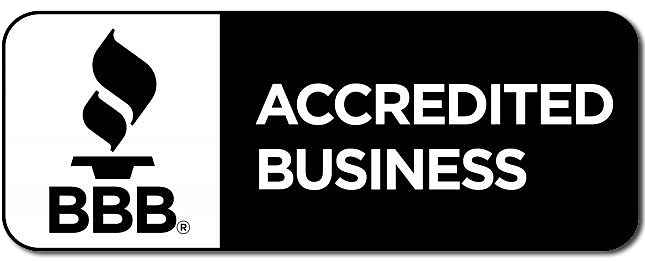Understanding Diamond Certificates – Palos Verdes Jewelry Stores
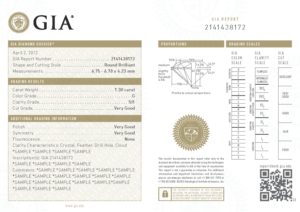 Diamond certificates are technically known as “diamond grading reports” among Palos Verdes fine jewelers. However, consumers often hear them referred to as certificates, so that is the term we’ll use for the purpose of today’s discussion.
Diamond certificates are technically known as “diamond grading reports” among Palos Verdes fine jewelers. However, consumers often hear them referred to as certificates, so that is the term we’ll use for the purpose of today’s discussion.
Diamond certificates are reports issued by professional gem evaluating laboratories that assess and verify the quality of loose diamonds. The main aspects evaluated in a certificate are the famous “Four Cs”–color, cut, clarity, and carat weight.
Diamond certificates allow buyers to purchase with confidence based on the attributes of the diamond rather than the persuasiveness of the retailer. Certified diamonds hold their value better than non-certified diamonds, and diamond certificates simplify the process of comparing one diamond to another.
When purchasing a diamond, make sure the diamond certification is from a reputable gemological laboratory, and not one associated with the retailer or wholesaler. Also, be aware of the difference between an appraisal and a certificate. Appraisals are typically prepared by the seller and denote the estimated value of a diamond for insurance purposes.
A diamond certificate is an unbiased analysis of a diamond’s specific qualities. While most respected agencies should provide an unbiased assessment, bear in mind that apart from carat weight, all assessments are at some level subjective, and can vary from one evaluating agency to another. Also, the different certifying agencies can employ different scales and designations for color, cut, and clarity, making direct comparisons difficult at times.
In the following article from Palos Verdes Diamond Buyer, we’ll define some of the terms used in diamond certificates, as well as compare the various certifying agencies.
Graded Characteristics of Certified Diamonds
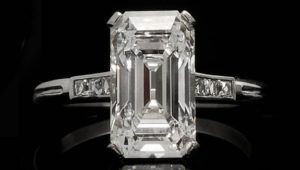 The Four C’s of diamond grading (carat weight, color, clarity, and cut) were developed by the Gemological Institute of America in the 1950s as a way to compare and evaluate loose diamonds. They are now an internationally accepted industry standard.
The Four C’s of diamond grading (carat weight, color, clarity, and cut) were developed by the Gemological Institute of America in the 1950s as a way to compare and evaluate loose diamonds. They are now an internationally accepted industry standard.
Carat is a unit of weight, not size, and is precisely measured on electronic microbalances to the fifth decimal place. There are five carats in a gram, and each carat is divided into 100 parts, called points, so a quarter carat diamond would be 25 points.
The color of a certified diamond is actually its lack of color—a perfect diamond would have no hue. Color is determined by comparison to master stones of predetermined color under standardized viewing conditions with controlled lighting and backgrounds.
Clarity of a certified diamond refers to internal flaws, called ‘inclusions,’ and external flaws, called ‘blemishes.’ While no diamond is completely pure, the closer it is to perfect, the higher its value. The number, size, relief, nature, and position of these characteristics is carefully determined and recorded.
A diamond’s cut refers not simply to the shape of the stone, but more specifically how well a diamond’s facets interact with light. A diamond’s cut is the most crucial element in the stones overall beauty and value. And of all the Four Cs, cut is the most complex and technically challenging element to analyze.
Also included in most certificates is the diamond’s laser inscription registry number (if applicable), and other basic information like shape, measurements, and more specific analyses of fluorescence.
The Gemological Institute of America
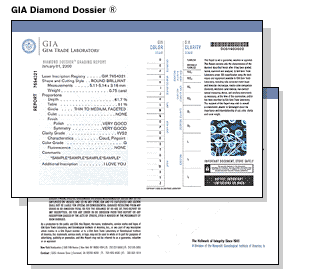 In addition to creating the Four Cs and setting the standards for diamond grading, the not-for-profit Gemological Institute of America (GIA) is considered to be the most respected and strictest diamond grading laboratory in the world. The GIA offers two certificates, a Diamond Dossier and a Diamond Report.
In addition to creating the Four Cs and setting the standards for diamond grading, the not-for-profit Gemological Institute of America (GIA) is considered to be the most respected and strictest diamond grading laboratory in the world. The GIA offers two certificates, a Diamond Dossier and a Diamond Report.
The Diamond Dossier is issued in two types, with and without cut details, and provides basic information on the Four Cs as well as the stone’s fluorescence and measurements. If cut information is included, more detailed dimensions of the stone are provided such as table size, crown and pavillion angles, and girdle thickness.
The Diamond Report is slightly more detailed than the Dossier. GIA Diamond Reports contain all the basic information included in the Dossier, plus a detailed schematic of the stone’s inclusions and blemishes.
The GIA grades Color on a scale from D to Z, with D being the highest quality and Z the poorest. Diamonds graded D-F are considered Colorless, G-J Near Colorless, K-M Faint Yellow, N-R Very Light Yellow, and S-Z Light Yellow.
The GIA cut scale ranges from Excellent to Very Good, Good, Fair, and finally Poor.
Clarity is graded using 10x magnification, so by definition, if a flaw is not visible at 10x magnification, it does not affect the diamond’s clarity grade. The GIA uses the following designations for clarity:
- Flawless/Internally Flawless–no inclusions visible by an expert at 10x magnification
- VVS1-VVS2–Very, Very Slight Inclusions very difficult for an expert to find at 10x magnification.
- VS1-VS2–Very Slight Inclusions difficult for an expert to find at 10x magnification.
- SI1-SI2–Noticeable inclusions, relatively easy to find under 10x magnification. Not visible without magnification in a face-up direction.
- I1-I3– Inclusions obvious under 10x magnification, and may be visible to the naked eye. I3 inclusions may affect the diamond’s durability.
The American Gem Society
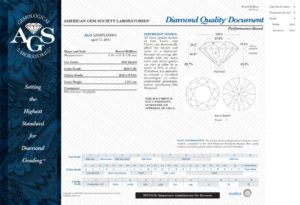 The American Gem Society (AGS) was founded in 1934 by the creator of the GIA, and its laboratory is widely respected as a reputable facility with strict standards.
The American Gem Society (AGS) was founded in 1934 by the creator of the GIA, and its laboratory is widely respected as a reputable facility with strict standards.
The AGS offers a wide range of report options, but their “Diamond Quality Document” is their basic evaluation, and it will contain the same kinds of information in GIA certificates.
The AGS uses a unique and proprietary 0-10 grading system for cut, color, and clarity, making it a bit more intuitive than the GIA system–however, to assist those accustomed to the GIA system, their report also shows the GIA letter equivalents to the AGS number scale.
The highest possible grade is zero, and 10 is the lowest, so a diamond with a color grade of 3 would have less color than a diamond with a color grade of 5. A perfect diamond would be a 0-0-0, the highest ratings in Cut, Color and Clarity respectively.
The Diamond High Council (Hoge Raad voor Diamant, HRD)
 The non-profit HRD Certificates Laboratory is one of the largest diamond certification labs in the world, and maintains an excellent reputation for quality and objectivity.
The non-profit HRD Certificates Laboratory is one of the largest diamond certification labs in the world, and maintains an excellent reputation for quality and objectivity.
Their benchmark certification is a “Natural Diamond Certificate,” a comprehensive description and grading of the Four Cs and detailed diagram plotting any inclusions and blemishes.
Color is graded on a scale from Exceptional White to Tinted Color, though the GIA’s D to Z equivalent is also included. Clarity is graded on a scale from Loupe Clean (Flawless) to P3 (imperfect).
Clarity is judged as ‘proportions,’ and ranges from Very Good to Good to Unusual. Also included is a Finish Grade, based on the quality of the workmanship of the diamond polisher.
International Gemological Institute
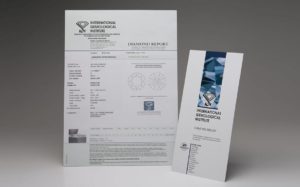 The International Gemological Institute was founded in Antwerp in 1975, and it now has labs throughout the world. Their IGI Diamond Report includes an analysis of the Four Cs, but they tend to grade diamonds looser in color and somewhat looser in clarity when compared to the GIA.
The International Gemological Institute was founded in Antwerp in 1975, and it now has labs throughout the world. Their IGI Diamond Report includes an analysis of the Four Cs, but they tend to grade diamonds looser in color and somewhat looser in clarity when compared to the GIA.
What might be graded VVS1 by the GIA can be graded slightly higher at IF-/VVS1, and color grades are consistently one grade higher in the IGI report.
EGL USA
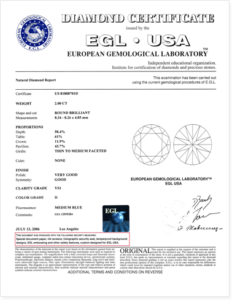 The European Gemological Laboratory was founded in Belgium in 1974 and is now made up of EGL International and EGL USA. The EGL is known for introducing grading techniques for diamonds weighing less than one carat, and for establishing the “SI3” rating for diamond clarity.
The European Gemological Laboratory was founded in Belgium in 1974 and is now made up of EGL International and EGL USA. The EGL is known for introducing grading techniques for diamonds weighing less than one carat, and for establishing the “SI3” rating for diamond clarity.
Over the years, many inconsistencies have occurred with diamond reports issued by labs operated by EGL International. Therefore, EGL USA is the only lab whose reports we (and many other industry professionals) recognize as being useful.
EGL USA is a for profit entity, and as such they tend to grade their diamonds more loosely than the GIA. As a general rule, an EGL USA certified diamond will compare equally in quality to a GIA certified diamond that is graded two color grades and one clarity grade lower.
For example, an EGL certified diamond graded G in color and VS2 in clarity is comparable to a GIA certified diamond graded I in color and SI1 in clarity.
How to Sell Your Diamond Ring in Palos Verdes
Although it is helpful to have a diamond report when selling your large carat diamond jewelry, Palos Verdes Diamond Buyer does not require one. We employ GIA graduate gemologists and estate diamond buyers with decades of industry expertise to ensure that you receive the best possible cash offer for your diamond rings and other diamond jewelry.
To receive a free Palos Verdes diamond appraisal and a generous cash offer, contact our diamond buyers today.
Call (424) 271-5986
To learn more about the process of selling a diamond for cash, please check out our article: How to Sell a Diamond Ring.
Understanding Diamond Certificates
